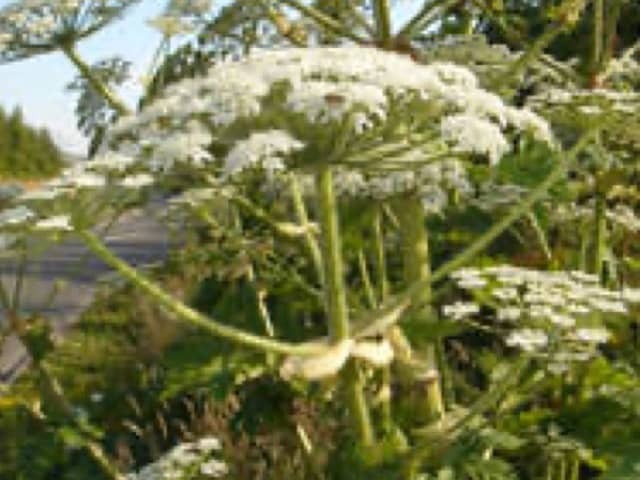Main menu
Common skin conditions

NEWS
Join DermNet PRO
Read more
Quick links
Author: Hon A/Prof Marius Rademaker, Dermatologist, Hamilton, New Zealand,1999.
Common name: |
Giant hogweed |
Botanical name: |
Heracleum mantegazzianum Sommier et Levier |
Family: |
Giant hogweed belongs to the Apiaceae family (or Umbelliferae), which has over 2500 species in 275 genera. These include common herbs such as cow parsnip (sometimes called hogweed) anise, carrot, celery, coriander, dill, fennel, parsley, and parsnip, as well as the highly toxic hemlocks. |
Origin: |
Native to Asia, more specifically the western Caucasus but it is now widespread in Europe and North America. In the USA this species escaped from cultivation and has become a public health hazard, being found in urban, suburban and rural settings. Giant hogweed is usually found in sunny, moist and disturbed habitats. It is a serious weed that invades areas likely to have high use by people, such as river and stream banks, roadsides and right-of-ways. |
Description: |
It is a giant perennial herb that varies in height from 2.0 to 5.0 m, which may live for several years. It has a large and dark reddish-purple stem (c. 10 cm in diameter), and spotted leaf stalks, both of which are hollow. The compound leaves of H. mantegazzianum may expand to over a meter in breadth, with each leaflet being deeply incised. The inflorescences are composed of many small white florets and arranged in large umbels that can grow to 1.0 m in diameter. |

Giant hogweed
Uses: |
It is a popular plant in gardens due to its attractiveness. |
Allergens: |
The sap of H. mantegazzianum contains psoralens (furocoumarins) that lead to phytophotodermatitis, which is produced by the interaction of such plant compounds with sunlight on human skin. The psoralens are lipid-soluble and penetrate into the epidermis with ease. The photochemical excitation of psoralens is induced by ultraviolet radiation, usually within the UVA wavelengths of 320-400 nm. Note that the absorption of psoralens into the skin (and the consequent reaction) is enhanced by high humidity. |
Allergy: |
Phytophotodermatitis is a phototoxic reaction, and not an allergic one so there is no immunological response. As a result, no prior sensitization is necessary and anybody can be affected. Heracleum mantegazzianum is one of the main causes of phytophotodermatitis in the UK and USA. |
Other information: |
Giant hogweed is on the USA federal noxious weed list, which means that its importation into the country is illegal, as is the interstate and intrastate movement of this species. In New Zealand H. mantegazzianum is listed in the National Plant Pest Accord, and it is an unwanted organism under the Biosecurity Act 1993, pursuant to section 2(1). This prevents its legal sale, propagation or distribution within New Zealand. |